French cars
News with a French Flavour

So what’s bubbling on the stove in France? Here are some new French cars soon to be coming onto the market. These models will definitely be sold in Europe, hopefully making their way south to roll onto our showroom floors.
Renault 5
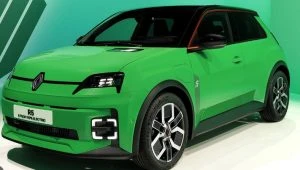
The all-new Renault 5 is back! This is a cool-as retro-inspired EV hatchback that has captured styling from the old Renault 5, embedding it into the new car’s design and detailing. Though a throwback to the iconic Renault 5 of the 1970s–1980s, the new wee car packs plenty of clever technology under its skin.
The interior is fresh and inspiring, and its clever infotainment system is integrated with Google services. The car’s two-step dashboard looks incredible, while the denim-like trim works nicely both as visual and tactile stimulation. The seats are made from recycled plastic bottles, and there are plenty of bright colour schemes for the upholstery and interior. You can even get a little wicker basket to sit in the passenger footwell for carrying your baguette! All the controls are nicely wrapped around the driver, and the new Renault 5 gets a 10.0-inch infotainment screen and a 7.0-inch digital driver’s display.
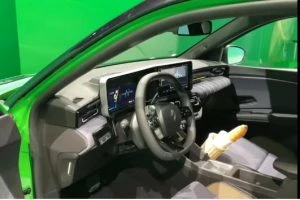
This is a direct alternative to the MG 4 and BYD Dolphin, as it boasts two battery options and a range of up to 390 km. Like the old one, this is front-wheel-driven, and there are three levels of power output to choose from. Entry-level cars have 71 kW, enabling it to run the 0–100 km/h dash in around 12 seconds. The 92-kW version performs the same sprint in 9.0 seconds. And the top of the range 112-kW version sees the little hatchback making it in around 8 seconds. There is even a suggestion that there will be a hot-hatch version of the new little Renault 5, known as the Alpine A290. So, for those looking for sizzling acceleration, this will be worth the wait.
A choice of two battery packs is available for powering the Renault 5’s electric motor. A 40-kWh pack is great for city commuting. There is also a larger 52-kWh battery pack, which gives you a further range. Both battery options will charge from 15% to 80% in around 30 minutes on a DC fast charger.
The new Renault 5 EV Hatch goes on sale in France in September of this year, where it’ll cost around £22,000 in the UK. Isn’t it great to see it back?
Peugeot 5008
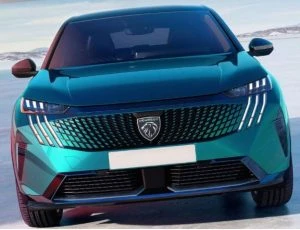
After a seven-seater EV SUV? There aren’t too many of these available; however, the new Peugeot 5008 boosts the options with its E version.
With similar styling to the E-3008, the Peugeot E-5008 shares parts with that car. Snazzy slim headlights are neatly hidden below the bonnet line, along with the car’s signature Peugeot three-claw LED DRLs. Side on, the Peugeot E-5008 is a boxy SUV, hinting towards the generous interior dimensions that are found inside.
The new interior styling and infotainment technology is brilliant. In fact, the Peugeot E-5008 has one of the most stylish and distinctive interiors we’ve seen in cars for a very long time. So, if that hasn’t pricked your ears up, then I’m not sure what else will. The multi-layered dash is wrapped in a groovy grey fabric, the major controls are angled towards the driver, and sitting proudly on top of the dashboard is a massive curved 21-inch screen that houses both the digital driver’s display and the infotainment system. The latest generation of Peugeot’s i-Cockpit system is incorporated into the style and function of the new screen.
With all seven seats in place, you have 259 litres of boot space to put your shopping bags into. A massive 748 litres of luggage space is available with the third row folded down. The Peugeot E-5008 can be had with a 98-kWh battery that is paired to a 172-kW electric motor. This is plenty of power with an equally impressive 650 km range. Then there is the 157-kW motor available, with its 73-kWh battery pack and a slightly shorter travel range. At the top of the tree sits a dual-motor Peugeot E-5008 model with close to 240 kW of power on tap. Its 73-kWh battery is said to provide this model with a range of around 500 km.
The Peugeot 5008 is also available as a hybrid version. Its rather smooth 102-kW petrol engine is mated to a six-speed dual-clutch automatic gearbox, and there’s an added electric motor to boost power and efficiency.
A plug-in hybrid joins the gang in 2025. This will use a 112-kW petrol engine paired to a 90-kW electric motor. This combined power output is nice and strong, while also making this PHEV capable of covering 75 km on electric power alone.
Citroen e-C3
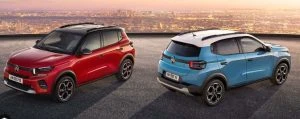
The new Citroen e-C3 has been revealed, and it is an affordable electric SUV boasting up to 315 km of range.
The e-C3 is a funky wee vehicle that is said to be a very affordable buy. It uses an 85-kW electric motor to power the front wheels, capable of propelling the car from 0 to 100 km/h in around 11–14 seconds, depending on the model.
The Citroen e-C3’s interior is comfortable, with some cool-looking fabric on the dash. The two-spoke steering wheel has that funky bit of French flair we all love. To keep the cost down, entry-level models have a mount for your phone instead of a touchscreen, which allows you to access satellite navigation, the radio, and music streaming in this way. All other models have a 10.25-inch touchscreen with all the goodies, and all cars have a classy digital driver’s display.
When these models make it Down Under, we’ll give them a full write-up in our car reviews pages, so if you’re interested, come back later for more.
Simca: A Forgotten Marque?
The first car I ever owned was a Simca. Before I owned it, I had never heard of the marque, and my dad, who had helped me find this set of wheels to get me to a summer job, described it as the French equivalent of a VW Beetle or a Mini. After that summer of using the Simca to get to my holiday job, I ended up selling it and using the money to buy a fridge, which I needed for my new flat. I have never heard or seen any other Simcas since then. Needless to say, there is that part of me that, now that I have left my student days well behind me and am probably officially middle-aged, is kicking myself for selling it (the fridge is also long gone). Especially as now, it would be worth a lot more than a refrigerator, given that would have been a fairly rare classic car. The same could probably be said by most of us about our student cars.
I cannot remember the model of Simca that I owned. However, a quick crawl through the range of images online suggests that it was probably a 1000 or 1100. Given that the engine was at the front (I remember almost ritually checking up the fluids every week on a Thursday, opening the bonnet to do so), I can therefore conclude that it was a 1100, as the 1000 had a rear engine, like a VW Beetle.
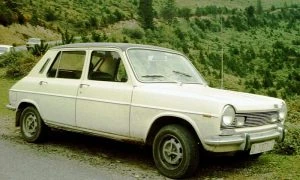
Simca 1100 – a wee trip down memory lane for me.
I have noticed blank looks similar to mine when I start talking about my first car. “Who makes that?” is quite a common question. As it would be nice to have a nice article to direct these dinner party guests to, I thought I’d put together a bit about Simca, what they made and what happened to them.
My father had called the Simca the French equivalent of the Beetle or Mini. He would have done better to say that Simca was the equivalent of the Fiat Bambina or Fiat 500. This is because the company, originally known as “Société Industrielle de Mécanique et Carrosserie Automobile” (that’s French for “Mechanical and Automotive Body Manufacturing Company”) was founded by Fiat in 1934 so they could outsource the production of their 508 and 518 models. Then World War 2 happened and Simca nearly went under, especially because of its Italian roots, and the Italians (under Mussolini’s Fascists) had been rather pally with the Nazis who had occupied France during the war. However, the company won a contract to repair US Army Jeeps, which put them on a sound financial footing.
For the next two or three decades, Simca grew slowly, although they were overshadowed by the better-known French marques, Renault, Citroen and Peugeot, especially Renault. However, it was successful in its home country, with the 1100 being one of the most popular cars in France by the late 1970s. Simcas were manufactured in a number of countries, including Australia, which is probably where the one I owned was made. The company also managed to take over the Talbot-Lago brand, with several Simca models also being sold with Talbot badging.
However, Simca was itself taken over, slowly and surely, by Chrysler. The American company bought a sizeable share of Simca in the late 1950s, although the company was still mostly a subsidiary of Fiat. Chrysler gradually edged Fiat out and took over the majority of shares in the 1960s. Finally, by the early 1970s, Chrysler took the company over completely and Simca’s name was changed to Chrysler France. The old Simca badge was phased out, with the last official Simca being made in 1973, which tells me that my car was older than me. After that, the cars made in Simca’s factories all had the Chrysler badge, including the Alpine and the Horizon.
I doubt I will try hunting down another example of my old Simca (presumably) 1100. If I were to look for a classic car, it would probably be something else, even though I thoroughly enjoyed driving my Simca, despite the lack of power steering and the fact that the speedo was in mile per hour, meaning that I had to do plenty of mental arithmetic during my daily commute to ensure I kept to the speed limit. However, given that Chrysler Europe was itself taken over by the Peugeot group in the late 1970s, I started speculated what the closest modern-day equivalent would be. I had a look at the latest offerings available from Fiat-Chrysler Australia (an appropriate blend of names, given Simca’s history) and decided that the closest thing was… the Fiat 500. Which is where Simca started, ouroboros fashion.
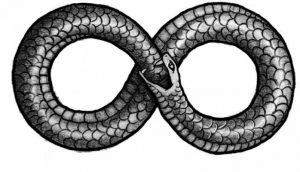
The Ouroboros – ending where it begins. Wouldn’t it make a great automotive logo?
New Cars to Buy – Exciting!
Along with the new SUVs showcased last time, Australia will also see some other exciting vehicles arriving in the coming months. Keep your eyes out for the following:
Honda
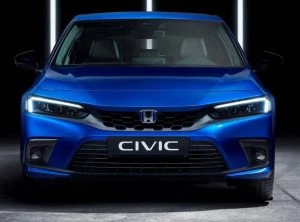
Civic Hybrid
Honda’s new Civic hybrid has its own subtle design features that set it apart from other Civic models. Hybrid-specific displays for the infotainment screen and instrument cluster gives the car its own environmentally friendly twist, plus the revised rear bumper is designed to conceal the exhaust outlets. Honda’s Civic Hybrid also gets blue accents for its Honda badges, and there is a special e:HEV tailgate badging to set it off nicely.
As a driver, the new Honda Civic Hybrid is an impressively competent vehicle with great economy and plenty of get up and go. The Civic HEV’s hybrid system is based around the 2.0-litre naturally-aspirated Atkinson-cycle petrol motor that is found in the current Honda Accord VTi-LX Hybrid. Matching the engine output to a smooth CVT automatic makes for an excellent easy car to drive. 315 Nm of torque provides grunt when you need it and the 135 kW of peak power suits this car well and delivers a bigger punch than the standard Civic’s 131 kW/240 Nm levels.
The front-wheel drive Honda Civic Hybrid is likely to be more efficient than the Accord Hybrid and even more so than Toyota’s Corolla Hybrid (4.2 litres/100 km).
BYD
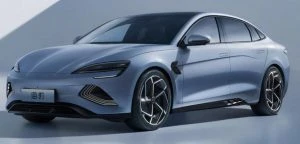
BYD Atto 4
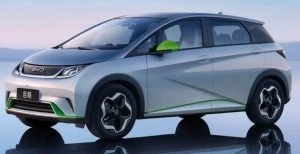
BYD EA 1 (Dolphin)
BYD Auto is the largest EV manufacturer in the world and is the automotive division of the Chinese multinational manufacturer BYD Company. Along with some SUV models, BYD is also bringing their Atto 4 sedan and their neat little EA 1 to Australia.
The BYD Atto 4 is a mid-size sedan that looks beautiful, sporty, and aerodynamic. Equipped with loads of the latest technology and also obtaining power from large batteries with a unique design, the Atto 4 impresses. Standard Atto 4 versions get a 61.4 kWh battery pack and a claimed 550 km range. The pricier models get a larger 82.5 kWh unique Blade battery with a claimed range of up to 700 km. Having the larger battery and an AWD system, this flagship BYD Atto 4 can reach 100km/h from a standstill in just 3.8 seconds!
More BYD excitement has the imminent arrival of the BYD EA 1 Hatchback. In China they call the BYD EA 1 the rather endearing name ‘BYD Dolphin’. This is a small Chinese EV hatchback that is being picked to be priced at or less than $30,000 in Australia. The small all-electric hatchback will be available with various battery and drivetrain configurations, all using a single electric motor to power the front wheels.
Two battery capacities: 30.7 kWh or 44.9 kWh will be available for the EA 1, both of which can be paired with a 70 kW/180 Nm motor. The larger 44.9 kWh battery can also be linked to a 130 kW/290 Nm motor, providing swifter acceleration and cruising speeds. Larger batteries will also become available over time for the little EA1 – particularly necessary, as Australia is a pretty vast land mass.
Managing director, Luke Todd, stated that “Our view is [that] in Australia any EV must have a minimum – even for city running – of 400 km to be accepted in the Australian market. All of our vehicles will have at least a 400 km range … our target is 500 km-plus.”
Cupra
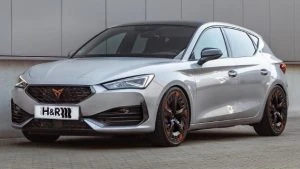
Cupra Leon
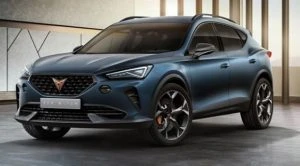
Cupra Formentor
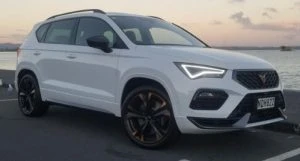
Cupra Ateca
Cupra is a Volkswagen-owned Spanish brand who have opened their doors to import their vehicles to Australia, offering us a 3-strong model range.
The exciting range of Cupra cars – Ateca (SUV), Leon (Hatchback), and Formentor (Crossover) – will spearhead the Australian line-up.
The Cupra Ateca SUV comes exclusively in the VZx form, so 221 kW of power and 400 Nm of torque is sent through the 4Drive AWD system to deliver 0-100 km/h in 4.9-seconds. I can see plenty of performance-SUV lovers who want to drive something as unique looking as the Cupra Ateca SUV wanting one!
The Cupra Leon Hatchback will be offered in VZ, VZe and VZx specification levels. So along with plenty of technology and differing variants, there will be a 2.0-litre turbo 140 kW/320 Nm, 180 kW/370 Nm, 180kW/400 Nm (Hybrid), and 221 kW/ 400Nm outputs respectively. So, there’s something for everyone here!
The Cupra Formentor is the Crossover Cupra and boasts the 4Drive AWD system on the V and VZx variants. Note the gorgeous crossover body styling that brings with it plenty of space, practicality and comfort.
All new Cupras sold in Australia will include a 5-year, unlimited kilometre warranty.
Volvo
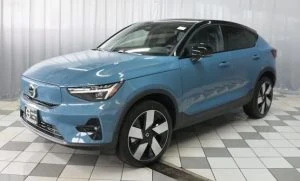
Volvo C40
Volvo has a new C40 coming! There are two versions offered that are based around one having a single electric motor and the other a dual electric motor layout. The Volvo C40 shares the electric powertrains with the XC40. Boot space is measured at 413 litres for both the single and dual motor versions.
Volvo’s the single motor C40 uses a 69 kWh battery pack and a single electric motor over the front axle. It produces 170 kW of power and 330 Nm of torque, combining nicely to provide drivers with a potential 0-100km/h dash being finished in 7.4 seconds. A full charge has a range of over 400 km.
Jump over to the Volvo C40 with its dual motor system, and you’ll find a larger 78 kWh battery pack. An electric motor for the front axle and an electric motor for the rear axle has this Volvo C40 equipped with AWD and capable of seeing off the 0-100km/h sprint in a claimed 4.7 seconds. That’s pretty swift! Again, a full charge should be able to take you over 400 km.
The single motor Volvo C40 kicks off at around $74,990, and the dual motor model around $82,490.
Audi
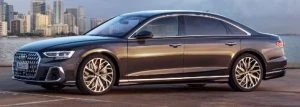
Audi A8
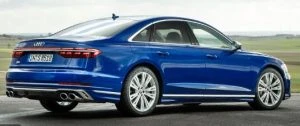
Audi S8
Audi’s A8 and S8 facelifts are coming. The A8 Sedan and Audi’s sportier S8 version have been a stunning proposition for some time, and they keep getting better. Quite an attractive large and luxurious sedan, the 2022 A8 delivers new levels of technology in the areas of comfort, entertainment, and safety.
The stunning A8 exterior remains similar to the outgoing model but you will find some nice subtle changes on the outside. 18–21-inch rims are available with six new designs to choose from. Audi’s ‘singleframe’ grille has been widened and pushed out at the bottom corners for a sportier, more athletic appearance.
The luxury sedan has grown a bit longer, making Audi’s flagship even more comfortable. It competes with the best big sedans from Mercedes Benz, BMW, and Lexus, so the relaxation seat package comes as no surprise, adding a back massage function, a foot warmer, an optional centre control console, and a fold-out table. 23 Bang and Olufsen speakers create an amazing audio sound.
Around the world, the new Audi A8 and A8 L versions will offer a wide selection of chiefly twin-turbo V6 engines that have 48-volt mild-hybrid assistance. All models will boast Quattro AWD and an 8-speed automatic. Audi S8 versions get the sweet-singing twin-turbo 4.0-litre V8 petrol ICE that can move this luxury–sports sedan from 0-100km/h in just 3.8 seconds. Boasting all-wheel steering, the S8 is a nimble thing of beauty.
Citroen
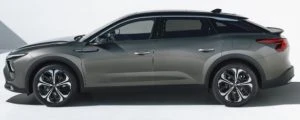
Citroen C5 X
Citroen calls the C5 X a “unique combination of the elegance of a sedan, the dynamism of a wagon and the elevated stance of an SUV”.
In my eyes, the new Citroen C5X looks both elegant and comfortable – just like a special Citroen should. The Citroen C5 X is a large 5-seater that measures 4805 mm in length. Luggage capacity is 485/1580 litres for the PHEV version and 545/1640 litres for the ICE car. Inside its cabin, you’ll find the C5 X is very comfortable, and the sensible interior layout is pleasant on the eye. A load of high-tech interior features include a digital driver’s display, a big 12.0-inch central touchscreen, Android Auto, Apple CarPlay, and a novel toggle gear shifter.
Adaptive dampers increase the Citroen C5 X’s ability out on the road, ensuring that those of us who love comfort can ride all day in a C5 X, all very comfortably indeed.
Equipped with the 165 kW/300 Nm 1.6-litre turbo-petrol four-cylinder ICE, the Australian version will have decent power (0-100 km/h in 8.8 seconds) while being hooked up to an 8-speed automatic transmission and FWD. A top speed of 232 km/h is doable. Citroen’s Australian importer is also considering launching the new Citroen C5 X with a PHEV powertrain. This system mates the 1.6-litre turbo ICE with an 81.2 kW electric motor and a 12.4 kWh lithium-ion battery for a total system output of 165 kW and a claimed electric range of 50 km (WLTP). The PHEV version is slightly quicker, boasting a 7.9 second time for the 0-100 km/h dash.
Peugeot
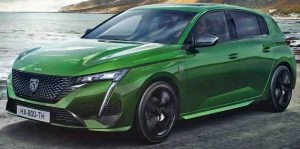
Peugeot 308
Peugeot is bringing us the next-generation 308 and the 3rd generation 308 is a classy looker from any angle you care to look at it from the curb side. Peugeot’s Australian line-up will consist of 4 variants: the 308 GT Hatch, 308 GT Premium Hatch and Wagon, and the Peugeot 308 GT Sport PHEV hatch – a plug-in hybrid (PHEV).
The PHEV versions of the 308 Hatch and Wagon will use larger batteries and more powerful motors than you’ll find in the smaller Peugeot e-208 supermini models. A Peugeot 308 GT Sport PHEV model sees a 132 kW 1.6-litre turbocharged 4-cylinder ICE unit paired to an 81 kW electric motor. The total output of the powertrain sends out a sprightly 165 kW of power and 360 Nm of torque to an AWD system for maximum traction and plenty of excitement.
New 308s with ICEs will be powered by a 1.2-litre turbocharged 3-cylinder petrol engine that produces 96 kW of power and 230 Nm of torque. This little engine is paired with an Aisin-sourced 8-speed automatic transmission that sends the power to the front wheels. Peugeot offers an e-308 in Europe, which is a pure electric variant.
Ford
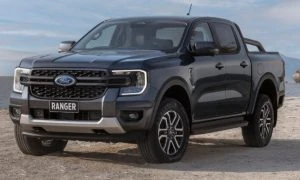
Ford Ranger Ute
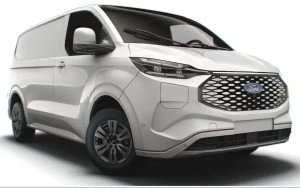
Ford E Transit
The new Ford Ranger Ute is packed with smart functionality and a cool ‘Tonka Toy’ appearance. Commands via voice, phone, or the central touchscreen has you controlling many of the infotainment features. Wireless phone charging, a smart climate control system, and a new digital cluster for the driver keeps the tough new Ford Ranger models at the head of the pack. Its chunkier styling with a wider stance, big towing capacity, and superior off-road ability are part of the new Ford Ranger experience.
Like the brand new Ford Everest SUV, the Ranger Ute houses the latest 3.0-litre turbo diesel V6 ICE, which is also offered alongside the existing 2.0-litre twin-turbo 4-cylinder diesel engine for 2022/23. The V6 boasts 184 kW of power at 3250 rpm and 600 Nm of torque from 1750-2250 rpm.
Ford’s latest E-Transit vans will be available with an all-electric powertrain for more efficient, zero-emissions driving.
Genesis
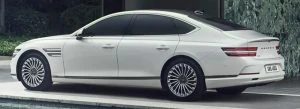
Genesis G80 Sedan
The charming Genesis G80 Sedan has gone pure EV and it is a stunner on the styling front. The car’s opulence and quiet ride will impress. An 87.2 kWh lithium-ion battery pack is housed under the floor, and a claimed Worldwide Harmonised Light Vehicle Test Procedure (WLTP) range of over 500 km is a decent amount of travel. The G80 EV Sedan has a pair of electric motors that work in unison to develop a maximum of 272 kW. This level of power combines with instantaneous torque of up to 700 Nm. These are powerful figures, allowing the luxurious Genesis Sedan to sprint from 0-100 km/h in less than 5 seconds.
Classic Citroen
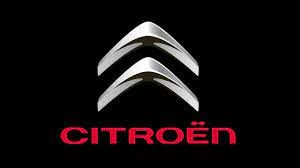
As mentioned in a more recent blog, Stellantis is official: PSA and FCA have merged under the name Stellantis. The name Stellantis originates from the Latin verb “stello” which means “to brighten with stars”. Car maker, Stellantis, now has 14 car brands under its wing, and they include: Abarth, Alfa Romeo, Chrysler, Citroen, Dodge, DS Automobiles, Fiat, Jeep, Lancia, Maserati, Opel, Peugeot, Ram, and Vauxhall. As far as its size goes, Stellantis is now the 4th-largest carmaker in the world, behind Toyota, VW Group, and the Renault-Mitsubishi-Nissan Alliance.
As you might have noticed, one of the 14 car brands is Citroen. Stellantis is planning to launch a new model under the Citroen brand for India and Latin America in 2022. The idea is for Stellantis to push outside the boundaries of its conventional European sales territory and branch further into emerging markets where it has had much less exposure.
Citroen left India in the 1930s, so some water has certainly past under the bridge since then. At a time when some other foreign carmakers are leaving India after struggling to make a profit there, Stellantis is seizing an opportunity with its Citroen-based products and heading straight on in. The company recently said it plans to produce a new version of the Citroen C3, which is commonly a city car in Europe, will be launched into India and Latin America in the second half of 2022. The car will be produced in India through a joint venture with CK Birla, and in Brazil. It is likely to be the first of 3 models aimed primarily for India and Latin America – these 3 models being produced over the next 3 years. By 2030, Stellantis expects India to become the world’s 3rd biggest car market after China and the U.S.
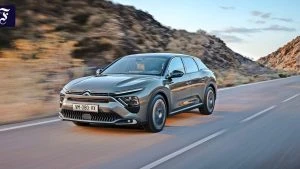
Citroen C5 X
However, Stellantis isn’t running away from Europe car markets anytime soon. It is well-known that the big German brands are dominating the midsize car segment in Europe, however Stellantis’s European focus is ramping up. Following the Peugeot 508 and glorious Citroen DS9, Citroen has a new flagship model that they want to put against the classy Mercedes E-Class, BMW 5 Series, and Audi A6 models. What is exciting is that the new Citroen C5 X will be a car that is a bit sedan, a bit wagon and a bit SUV in its design. The relatively flat roofline has a bit of sedan in its lines. The drawn-out rear-end brings the station wagon style, and then the tall ride height is more SUV – reminiscent of the C5 Aircross. At 4805 mm long, 1865 mm wide and 1485 mm tall, the new Citroen C5 X is smaller than its potential German rivals. It offers 545 litres of boot space behind the rear seats, which can be expanded to 1640 litres after the rear seats have been folded flat.
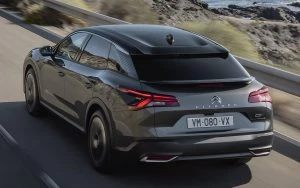
Citroen C5 X
It has to be said that the new Citroen C5 X boasts a quirky exterior that takes after the 2016 Cxperience concept. Its interior will be loaded with technology – all the very best tech that Citroen has to offer. A 12-inch touchscreen for infotainment, a large head-up display with support for augmented reality, a fully digital driver’s display, separate physical controls for the climate-control settings, sumptuous seating, and superior ride quality and comfort are just some of the features of the soon-to-be available Citroen C5 X will provide.
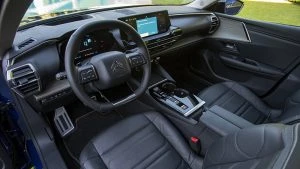
Citroen C5 X
Speaking of Citroen ride quality, the new Citroen C5 X flagship will come with the patented Citroen Advanced Comfort suspension, with the plug-in hybrid version making comfort even further advanced by featuring an active suspension. It boasts what the French automaker refers to as Progressive Hydraulic Cushioning, which when combined with exceptionally comfy seats, it should enable a silky-smooth ride even on bumpy surfaces – all in legendary Citroen fashion.
A variety of petrol-fed engines are planned; however, Citroen highlights the plug-in hybrid powertrain with 168 kW and more than 50 km of electric range as a special model to take on the gradual change to hybrid and EV technology. The Citroen C5 X PHEV model will be able to travel at speeds of up to 135 km/h in full electric mode.
The brand-new Citroen C5 X, made under the Steallantis name, will go on sale in Europe in the second half of 2022. Let’s hope that we see it as part of Citroen Australia’s line-up, too. With Australia’s growing love of the SUV, it would seem a logical model to bring over here…
For something a little different!
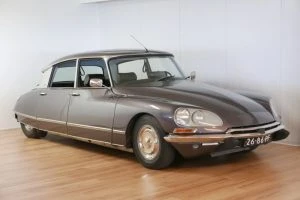
Citroen DS 1970
The 1955–1975 Citroen DS is still regarded as one of the most unique and interesting cars to have ever been made. The idea of retrofitting one of these to modern electric propulsion would be in the spirit of all things Citroen. A company known as ‘Electrogenic’ decided to reinvent the Citroen DS model with a battery-powered conversion.
The Oxford-based company retained the original car’s aerodynamic body but swapped the 2.0-liter petrol-fed engine for a brushless electric motor that produces 89 kW of power and 235 Nm of instant torque – a rather meaty performance upgrade. Interestingly, the power is delivered to the front wheels through the car’s original manual gearbox.
Providing the electric energy for the powertrain is a 48.5-kWh battery pack that is housed within the DS’s body. Electrogenic stated a real-world driving range of about 225 km per charge was doable. A 29-kW charger will refill the batteries to full capacity in about two hours. If the customer wanted a larger battery for a higher range between charges, it can be provided in a combination with a more powerful charger.
One of the fine attributes of the old Citroen DS was its silky-smooth hydro-pneumatic suspension. Electrogenic has also improved the hydro-pneumatic system by replacing the standard mechanical pump with an electric pump, which is more silent and delivers a more sophisticated ride than the original.
From the outside, the only visual differences between the original DS and the electric-powered conversion are the lack of exhaust pipes and the subtle but distinctive “DS EV electronique” decal on the boot.
Steve Drummond, director of Electrogenic, says that “Repowering classic cars with all-electric drive brings a number of benefits, from the ease of use to reliability and performance gains”. Of course, the quiet EV function brings out the best in old-timer classics.